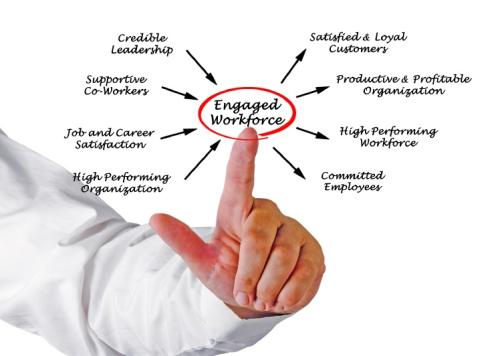 According to the 2014 Conference Board CEO Challenge, “Building a culture that supports engagement, employee training, leadership development, and high performance is something companies can control, and can mean the difference between growing market share and simply surviving in 2014.”
According to the 2014 Conference Board CEO Challenge, “Building a culture that supports engagement, employee training, leadership development, and high performance is something companies can control, and can mean the difference between growing market share and simply surviving in 2014.”
But that lofty statement includes more than just the CEO’s effort. That means managers – at every level – have got to build some intention around how to better stimulate and engage teams on the front line.
And there are good reasons to be focused on this effort.
-
The American Management Association says the cost of turnover ranges from 25%-250% of annual salary per exiting employee
-
The average monthly turnover rate in the US is 3% (astounding, especially in this economy).
-
Turnover incurs costs that are both financial, and institutional. Precious business continuity falls victim to high turnover rates.
Here are 7 tips to Improve Employee Engagement & Reduce Turnover
These ideas are all things YOU can control, as engagement is deeply influenced by the relationship with the direct manager.
Generally these don’t include organizationally driven topics like salary levels and total comp. However, as managers you do have ability to influence those, and, employees should have a clear sense for what their glide path is around total comp, and how to move from one level to the next.
1. Develop a sense of self-awareness as a manager.
Leadership, and management, begins with knowing how you show up in the world. The first step in becoming better as a manager is to become more aware of yourself, your style, and how you work with others.
Solution:
Take a quick assessment to understand:
-
What is your management style?
-
What are your strengths and weaknesses as a manager?
-
Do your employees know what is expected of them?
-
Do you delegate and oversee work effectively, without micro-managing?
-
Are your meetings effective and productive?
-
Are you able to communicate the organization’s vision and mission to your team?
-
Do you create line of sight to demonstrate how they fit into the larger organization?
-
How much do you respect your team, and how do you demonstrate respect for them?
-
What is the level of trust between you and your team?
-
How much do they respect you?
-
Do they feel safe enough to talk to you when they’ve made a mistake, or when they are not sure of something?
-
How would you describe the morale of your employees?
Use these types of reflective questions, as well as other emotional intelligence and typology indicators to understand your profile as a leader. Great leaders know themselves, and how they show up in the world.
2. Forget the surveys, have a conversation with them.
It always amazes me when I work with clients, how uncomfortable they feel talking with their manager about issues or challenges in the workplace. Often, they would rather quit their job than deal with that conversation.
Do you create an environment where employees feel comfortable coming to you with uncomfortable conversations? I suggest you must.
Solution:
Break down the barriers by holding regular meetings in which employees can offer ideas and ask questions. Have an open-door policy that encourages employees to speak frankly with their managers without fear of repercussion.
In short, forget the “employee engagement” surveys, have a conversation.
Leverage one on one conversation to build relationships and trust.
Understand that employees have fears and concerns. The better you understand these, the more open and honest your conversations with them can be (and vice versa).
3. Build trust with them.
Without trust your team cannot learn. Without trust it is not OK for them to say, “I don’t know,” “I have an issue,” or “I trust you back.” They will not be able to learn what they don’t know, or feel comfortable pointing out a huge mistake you might be considering.
Solution:
Use these tips on building trust:
-
Be consistent. Say what you do, do what you say. Treat everyone respectfully and differentiate only when performance demands that you should.
-
Be open to being wrong, or not having every answer. And then be willing to find it.
-
Make sure employees know you are “for” them. Too many clients are thinking, “My boss is out to get me.” If you have an issue, be clear and honest about what it is, and how you will tackle it together. Tell them how they make the team, and the organization, better.
-
Meet them where they are; don’t talk down to them, don’t talk over their heads. Realize that not everyone has your expertise, background or work style.
-
Don’t put lipstick on bad news. When there’s bad news, acknowledge the reality and keep moving forward.
-
Be credible. They may have worked jobs you didn’t. That’s OK. Acknowledge what they bring, and what you bring, and that it may not be the same.
-
Find common ground where you have it. We all have things that bring us together. Being on a common mission for the organization is one.
-
Share your perspective. I see that employees often grossly underestimate the pressures and priorities managers are trying to juggle. Make sure they know what you are accountable for, so that they know how to best support you.
4. Build Community with them.
Without community, employees lack one of the key motivators that we know engages people in the workplace: The sense of being a part of something bigger than themselves.
Solution:
Don’t underestimate the value of having fun, whether it’s team lunches or off site activities. It doesn’t have to be complicated or expensive. By getting to know people more personally, you’ll learn more about how to work effectively with them professionally.
5. Define roles and responsibilities for them.
One of the biggest issues employees have when we talk about engagement is the lack of clarity around roles and responsibilities. It’s essential to show everyone how they are expected to contribute to the team. It’s also essential that they know how they fit into the work that others are doing.
If they don’t know exactly what their jobs entail and what you need from them, they can’t perform up to standard. Then morale and engagement begin to slide. When employees are uncertain about what’s expected of them, they don’t know how they’ll be evaluated, and that causes distress.
Solution:
Articulate clear goals, milestones, and deliverables. Be specific and ensure that any ambiguity in the system is clarified.
Not only do you need to share this information, you need to continually verify that the employee heard what you shared in the way you intended.
Then you must give people timely, regular and fresh feedback so they know how they are doing, and where they must improve.
6. Recognize them.
In follow-up to the above point, employees need to know when they are on point, and when they are not.
Equally as importantly, they need to be recognized when they are doing well, and their contributions are having an impact. It doesn’t necessarily mean people are praise junkies. But it IS about creating a sense of meaning in the work they do every day. We all want to know that what we do matters. Recognition is one way to share that.
Solution:
Include recognition as part of your one on one and group communications. It’s more than telling people “Great Job” on something, though. It’s also about connecting that great job to the bigger picture. That means sharing how people have impact on the organization.
For example, “Josh when you nailed that report for the VP, it gave the team tremendous credibility in the executive suite. Well done!”
See how that’s more meaningful than, “Hey Josh, great job on that report. Thanks!”
7. Grow them.
The ability to get better at what we do and develop a sense of mastery, is a key driver for employee engagement. People want to become better at what they do. Often, the ability to develop new skills elsewhere will inspire them to leave the organizations.
Solution:
Provide development opportunities, coaching and technical training in situations where people have the capacity and desire to develop. Include this as part of your performance management expectation.
With the glut of online courses, self-paced instruction and numerous other learning modalities, development no longer has to be an expensive or complicated endeavor. By giving people a chance to leverage these new skills in the workplace, you feed them the nourishment of learning, while engaging them with the mission at hand.
What are you doing to address the “engagement crisis” facing our workplaces today, and what specific steps will you take to focus on building a culture that supports engagement with your teams?
 Written by Lea McLeod, M.A., Founder of The Job Success Lab- Lea empowers employees to make more money, have more time, and find more meaning in their jobs. She spent most of her career leading and managing global teams, and most recently served as Director of a $1.3 B program at Hewlet-Packard. Now, she helps others discover the “success factors” for their careers. The Job Success Lab is a suite of tools that helps your employees become more effective at what they do. In working with clients, Lea discovered some interesting stuff. People struggle in dealing with their managers – Big Time. And, they struggle with the basics: effective communication, difficult conversations, advocating for themselves, and getting out of work on time by focusing on the most important work during the day. She helps employees like yours get more out of each day, and make each day better. Which makes managers better. And more successful. She holds a degree in Marketing from St. Bonaventure University, and a Master of Arts in Organization Development from Seattle University.
Written by Lea McLeod, M.A., Founder of The Job Success Lab- Lea empowers employees to make more money, have more time, and find more meaning in their jobs. She spent most of her career leading and managing global teams, and most recently served as Director of a $1.3 B program at Hewlet-Packard. Now, she helps others discover the “success factors” for their careers. The Job Success Lab is a suite of tools that helps your employees become more effective at what they do. In working with clients, Lea discovered some interesting stuff. People struggle in dealing with their managers – Big Time. And, they struggle with the basics: effective communication, difficult conversations, advocating for themselves, and getting out of work on time by focusing on the most important work during the day. She helps employees like yours get more out of each day, and make each day better. Which makes managers better. And more successful. She holds a degree in Marketing from St. Bonaventure University, and a Master of Arts in Organization Development from Seattle University.
Do you have a question for Lea? Post it in our Middle Manager Community, she will be happy to help: Ask An Expert
Did you find this story informative? We would like the opportunity to keep you up to date on all of our training articles. Please Sign Up for our newsletter so we can do just that.
Here are some related articles you may be interested in:
Overcoming Disconnect Between Middle & Upper Management
Drive Your Team With One Simple Tool
Sucess Tips for Middle Managers
Dealing With Difficult Personalities
4 Essential Skills for Leaders, Managers & High Potentials
About ManagingAmericans.com
Organizational Strategy & Teambuilding Tools for Business Leaders & Managers- helping leaders achieve profitable results w/ fewer resources & happier employees. Our well-rounded business content is designed for leaders & managers to implement change with ease & improve accountability amongst their teams.